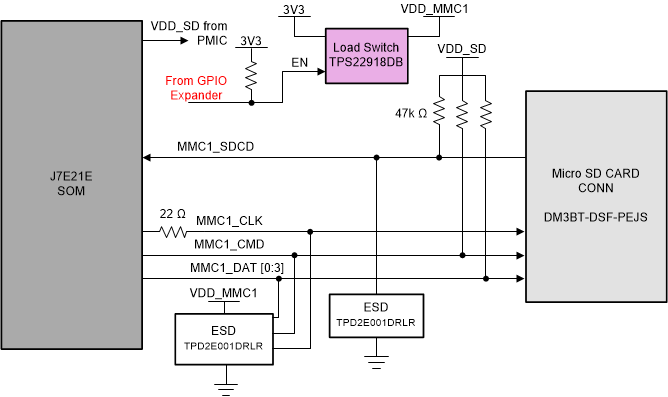SPRUIS4E March 2022 – January 2024
- 1
- Jacinto7 J721E/DRA829/TDA4VM Evaluation Module (EVM)
- Trademarks
- 1Introduction
- 2J721E EVM Overview
- 3EVM User Setup/Configuration
-
4J721E EVM Hardware Architecture
- 4.1 J721E EVM Hardware Top level Diagram
- 4.2 J721E EVM Interface Mapping
- 4.3 I2C Address Mapping
- 4.4 GPIO Mapping
- 4.5 Power Supply
- 4.6 Reset
- 4.7 Clock
- 4.8 Memory Interfaces
- 4.9 MCU Ethernet Interface
- 4.10 QSGMII Ethernet Interface
- 4.11 PCIe Interface
- 4.12 USB Interface
- 4.13 CAN Interface
- 4.14 FPD Interface (Audio Deserializer)
- 4.15 FPD Panel Interface (DSI Video Serializer)
- 4.16 Display Serial Interface (DSI) FPC
- 4.17 Audio Interface
- 4.18 Display Port Interface
- 4.19 MLB Interface
- 4.20 I3C Interface
- 4.21 ADC Interface
- 4.22 RTC Interface
- 4.23 Apple Authentication Header
- 4.24 EVM Expansion Connectors
- 4.25 ENET Expansion Connector
- 4.26 CSI Expansion Connector
- 5Revision History
4.8.4.2 MMC1 – Micro SD Interface
The EVM supports a Micro SD card interface connected to MMC1 port of SoC. The Micro SD card socket Mfr. Part# DM3BT-DSF-PEJS is interfaced with MMC1 port of SoC. This supports UHS1 operation including I/O operations at both 1.8 V and 3.3 V. The Micro SD card interface is set to operate in SD mode by default.
The I/O voltage is controlled using the LDO that provides the I/O voltage for the MMC1 port. The SD Card power is provided using a load switch, which is controlled by a GPIO from I/O expander. Control signal “GPIO_uSD_PWR_EN” is driven by the I2C I/O expander U31 Port02 on the CP board. This I/O expander is controlled by the processor’s I2C0 port. I2C address of the I/O expander is 0x22.
 Figure 4-14 micro-SD Card Block Diagram
Figure 4-14 micro-SD Card Block DiagramAn ESD protection device Mfr. Part# TPD2E001DRLR is provided for data, clock, command and card detect signals. The CD (card detect) pin of Micro SD card socket is pulled high and connected to CD pin of SoC. An external pull up resistor (47K) is provided on data [3:0] and CMD signals to avoid floating.